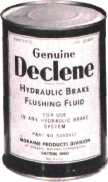|
1949 Delco Brakes Service Manual (Courtesy of Pat Gizz) |
|||
|
DELCO BRAKE SERVICE
MANUAL |
|||
|
|
|||
 |
When using the brake pedal to
flush the system, pedal should be operated slowly. The gravity filler
jar should always be refilled after bleeding each wheel so that there is
no chance of air getting into the system.
When using
a special pressure bleeding tank, never use more than 35 pounds air
pressure.
TEST FOR BRAKE SYSTEM LEAKS
Whenever
any adjustments or repairs are performed on the hydraulic brake system, a
good mechanic will want
to check his work to make sure that the brake system is operating at its
best. A quick check can be performed as
follows: |
||
|
Fig. 12óDeclene Flushing Fluid |
|||
|
|
|||
|
voir and through the system by
using a special pressure
bleeding tank or pressure pump.
The best practice is to flush one
wheel cylinder at a time by attaching a bleeder hose to the bleeder valve, and opening the bleeder valve
1-1/2 turns. When bright red Declene comes out of the hose,
that particular line and cylinder are flushed. Repeat the operation
in each wheel cylinder. Next, using Delco Brake Fluid instead of Declene,
repeat the foregoing operations. (See Instructions for Bleeding and
Refilling.) When the fluid comes out clear (no red fluid), the Declene is
out. Be sure that air is completely out of the cylinder before
tightening bleeder screw. |
1. With car raised off the floor, apply brake
pedal pressure sufficiently to make it barely possible to turn the wheels. This may be done
manually or by using a
brake pedal jack.
2. Any leak in the hydraulic system will cause
brakes to release gradually
after a few minutes and
the pedal will slowly go to the floor board as more pressure is
applied.
If leak is indicated, check all
connections and fittings, master cylinder primary cup, wheel cylinder
cups, and stop light switch. Also, remove boots or gear covers from wheel
cylinders and boot from master cylinder and inspect for evidence of
seepage. |
||
|
|
|||
|
--------------♦------------ |
|||
|
|
|||
|
BRAKE
FLUID |
|||
|
|
|||
|
If a brake fluid meets all the
year-around requirements, it must
exhibit many qualities.
(1) A good brake fluid must
withstand severely high operating temperatures. (Wheel cylinder
temperatures often reach 270".)
If the boiling point of the fluid is reached, vapor pockets form in
the lines. Since vapor (gas) is compressible (where liquid is not), spongy
pedal or loss of brake capacity results. |
(2) A good brake fluid must
retain fluidity at low temperatures. Failure to meet this requirement,
results in sluggish or inoperative brakes and hard
pedal.
(3) A good brake fluid must
not have any harmful effect on rubber parts. Swelling, softening,
blooming, or hardening of rubber cups is often caused by the use of cheap
fluids or fluids contaminated with grease, mineral oil, gasoline,
kerosene. |
||
|
|
|||
|
10 |
|||
|
|
|||